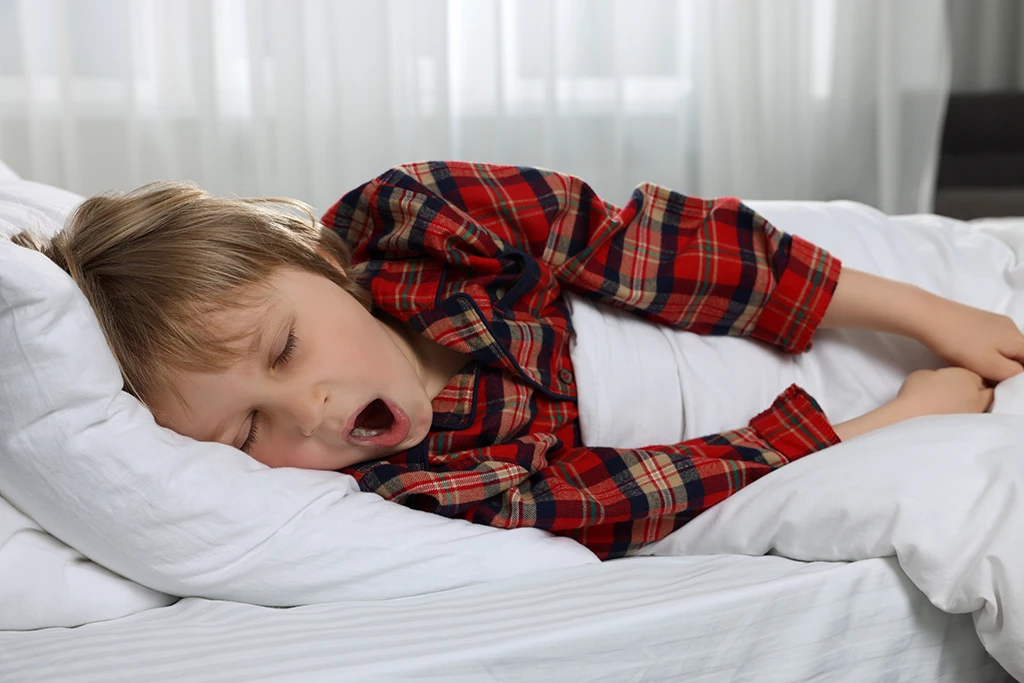Does My Child Have Sleep Apnea Quiz

Sleep is essential for your child’s health and development. If your child has disrupted sleep, it may be a sign of obstructive sleep apnea (OSA). In this condition, the airway becomes partially or completely blocked while the child sleeps. This article is a clear guide to pediatric sleep apnea. It explains the signs of sleep apnea and gives practical steps to protect your child’s well-being.
Pediatric Sleep Apnea Quiz
To help determine if your child might have sleep apnea, consider the following questions:

What Is Pediatric Sleep Apnea?
Pediatric sleep apnea happens when a child’s upper airway obstructs during sleep, causing pauses in breathing. These interruptions can happen multiple times per night, resulting in poor sleep quality and potential health issues. Unlike adults, children with sleep apnea may not always exhibit typical symptoms like loud snoring. Instead, they might display behavioral changes, daytime fatigue, and difficulty concentrating.
Signs Your Child May Have Sleep Apnea
Recognizing the signs of sleep apnea in children is crucial for timely intervention. Common indicators include:
- Loud Snoring: Persistent snoring, especially if it occurs multiple times a week, can be a sign of airway obstruction.
- Mouth Breathing: Breathing through the mouth during sleep or even while awake may indicate nasal airway obstruction.
- Restless Sleep: Frequent tossing and turning during sleep can be a response to breathing difficulties.
- Daytime Fatigue: Excessive tiredness during the day, despite adequate sleep, may result from disrupted nighttime breathing.
- Mood Swings: Poor sleep quality often causes irritability or mood swings.
- Difficulty Concentrating: Struggles with focus and attention in school or at home may stem from inadequate rest.
- Gasping or Choking Sounds: Noises such as gasping or choking during sleep are concerning signs.
- Nighttime Sweating: Breathing difficulties often cause excessive sweating during sleep.
If your child exhibits several of these symptoms, it may be time to consider a professional evaluation.

Importance of Early Diagnosis and Treatment
Early diagnosis and treatment of sleep apnea are vital to prevent potential complications, including:
- Behavioral Issues: Untreated sleep apnea can lead to behavioral problems such as hyperactivity and mood swings.
- Academic Challenges: Poor sleep quality can affect memory, learning, and attention, leading to academic difficulties.
- Growth Impairment: Disrupted sleep can interfere with growth hormone production, potentially affecting physical development.
- Cardiovascular Problems: Chronic sleep apnea may increase the risk of high blood pressure and other heart-related issues.
- Dental Concerns: Mouth breathing associated with sleep apnea can lead to dental issues like misaligned teeth and gum problems.
Next Steps: What to Do If You Suspect Sleep Apnea
If you suspect your child has sleep apnea, consider the following steps:
- Consult a Pediatrician. Discuss your observations and concerns with your child’s doctor.
- Undergo a sleep study. A sleep study (polysomnography) records your child’s sleep and detects breathing interruptions.
- Seek a Sleep Specialist. A specialist can provide a detailed assessment and recommend appropriate treatment options.
- Explore Treatment Options. Depending on the severity, treatments may include lifestyle changes, CPAP therapy, or surgical interventions.
- Monitor Progress. Regular follow-ups can help track your child’s response to treatment and make necessary adjustments.
Conclusion
Ensuring your child gets restful and uninterrupted sleep is crucial for their overall health and development. Recognizing the signs of sleep apnea early and getting prompt treatment can improve your child’s quality of life. If you are worried about your child’s sleep, talk to a healthcare professional to explore possible solutions.
References
- American Academy of Sleep Medicine. (2021). Pediatric obstructive sleep apnea.
- National Sleep Foundation. (2020). Sleep apnea in children.
- Mayo Clinic. (2019). Sleep apnea.
- National Institutes of Health. (2018). Obstructive sleep apnea.
American Academy of Pediatrics. (2017). Sleep and sleep disorders in children.


